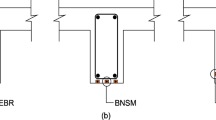Conclusions
-
1.
The special works performed on overhauling by the active anchoring method (with prestressed anchors) for strengthening the walls of the No. 8 lock of the Moscow Canal with strongly expressed signs of aging after 60 years of its intense operation increased the reliability of the walls and thereby increased the service life of the lock as a whole. In this case no interference to the passage of ships was created.
-
2.
This method made it possible not only to stop the process of irreversible movements of the top of the walls toward the chambers but also provided deflection of the walls to the opposite side. The goal of the top-priority measures to strengthen the walls was thereby achieved, making it possible to proceed to measures of the second phase — repair of the front faces.
-
3.
Compared with the passive anchoring method, prestressed anchors immediately enter into work, the uncertainty of the degree of remaining life after strengthening walls by them decreases, the anchors are more durable due to the anticorrosion sheath, and they provide quality control of the works by testing the strength of each anchor one by one, since the testing process is an element of the technology (“self-checking” technology).
-
4.
The method is recommended for strengthening hydraulic structures in which cracks are opening and sustained movements of separated parts are observed. It is effective at different stages of development of destructive phenomena; it is useful as a prophylactic means of increasing reliability, strength, and stability.
-
5.
The method is economical because the service life of the repaired structure is prolonged and it requires less metal than passive anchoring with comparatively smaller hole diameters.
-
6.
The following promoted the successful use of the method when repairing the lock walls: high degree of development of the technology created by Gidroproekt and checked by it in new construction on the Hoa-binh, Sayano-Shushenskoe, and Rogun hydrostations; its correspondence to international rules established by the International Federation on Prestressed Reinforced Concrete; the specialized character of the construction organization (the Geotekhnika firm) that carried out these works with a high quality on the No. 8 lock with improvement of the technology and the quality control.
-
7.
The method has ceased to be new. Its rather wide use during the past 10 years placed it in the ranks of the usual special works and well-mastered and reliable engineering means in construction. It is useful both in new construction and in reconstruction and repair of hydraulic structures as well as in other areas of construction.
Similar content being viewed by others
References
“Anchoring the navigation lock of the V. I. Lenin Dnepr hydroelectric station by deep (in holes) prestressed anchors,” in Express Information “Power and Electrification,” Series “Construction of Hydroelectric Stations and Assembly of Equipment”, Informénergo, Moscow, No. 7 (1981).
“Recommendations on the design and use of prestressed ground anchors,” in: Prestressed Reinforced Concrete (Based on the Proceedings of the Ninth FIP Congress), Stroiizdat, Moscow (1986).
Technical Instructions on the Design, Manufacture, and Assembly of Built-Up Structural Members of Reinforced-Concrete Bridges [in Russian], VSN 98-74 (Mintransstroi), Orgtransstroi, Moscow (1975).
V. E. Ni, “Results of observations of the state of hydraulic structures of the Moscow Canal,” Gidrotekh. Stroit., No. 12 (1977).
V. E. Ni, “Inspection of the reliability and safety of hydraulic structures of the Moscow Canal,” Gidrotekh. Stroit., No. 6 (1987).
V. E. Ni, Determination of Stresses in Retaining Walls of Hydraulic Structures [in Russian], Transport, Moscow (1995).
I. E. Pukhov, “Physical and mechanical properties of concrete of Moscow Canal locks,” Gidrotekh. Stroit., No. 8 (1988).
L. I. Medvedev, “Improvement of the electrical systems and the systems controlling the lock mechanisms of the Moscow Canal,” Gidrotekh. Stroit., No. 6 (1987).
O. D. Rubin, R. V. Umnova, and V. E. Ni, “Analysis of the behavior and strengthening of the dock walls of locks,” Gidrotekh. Stroit., No. 8 (1988).
O. D. Rubin, O. B. Lyapin, and V. E. Ni, “Strengthening operating retaining structures,” Gidrotekh. Stroit., No. 12 (1989).
Recommendations on Calculating the Stability of Rock Slopes [in Russian], Gidroproekt, Moscow (1986).
S. S. Antonov, Yu. B. Sudakov, and A. Yu. Karavaev, “Criteria for estimating the service life of aging concrete dams,” Gidrotekh. Stroit., No. 2 (1995).
G. L. Mazhbits, E. P. Bulanov, and V. S. Konyushevskaya, “Results of long-term observations of the stress-strain state of the walls of lock chambers of the Volgograd hydro development,” in: Central Bureau of Scientific and Technical Information on River Transportation. International Scientific and Technical Conference “Problems of Providing Stability and Safety of Hydraulic Structures [in Russian], Moscow (1995), pp. 38–45.
V. V. Balanin and M. A. Kolosov, “Basic principles of the technical guidelines on navigation locks”, in: ibid.,Central Bureau of Scientific and Technical Information on River Transportation. International Scientific and Technical Conference “Problems of Providing Stability and Safety of Hydraulic Structures [in Russian], Moscow (1995), pp. 54–57.
W. Mainhold, “Cracks on welded steel members of hydraulic structures on inland waterways of Germany; causes of defects and their elimination”, in: ibid.,Central Bureau of Scientific and Technical Information on River Transportation. International Scientific and Technical Conference “Problems of Providing Stability and Safety of Hydraulic Structures [in Russian], Moscow (1995), pp. 65–68.
S. V. Ternavskii, V. N. Zhukov, Yu. O. Zal'tsman, and A. A. Lyubomirov, “Strengthening the walls of the No. 8 lock of the Moscow Canal by prestressed anchors”, Gidrotekh. Stroit., No. 11 (1996).
Additional information
Translated from Gidrotekhnicheskoe Stroitel'stvo, No. 11 pp. 16–24, November, 1996.
Rights and permissions
About this article
Cite this article
Zhukov, V.N., Ternavskii, S.V., Zal'tsman, Y.O. et al. Effectiveness of repairing old reinforced-concrete walls of the No. 8 lock of the Moscow Canal by prestressed anchors. Hydrotechnical Construction 30, 654–663 (1996). https://doi.org/10.1007/BF02447443
Issue Date:
DOI: https://doi.org/10.1007/BF02447443




